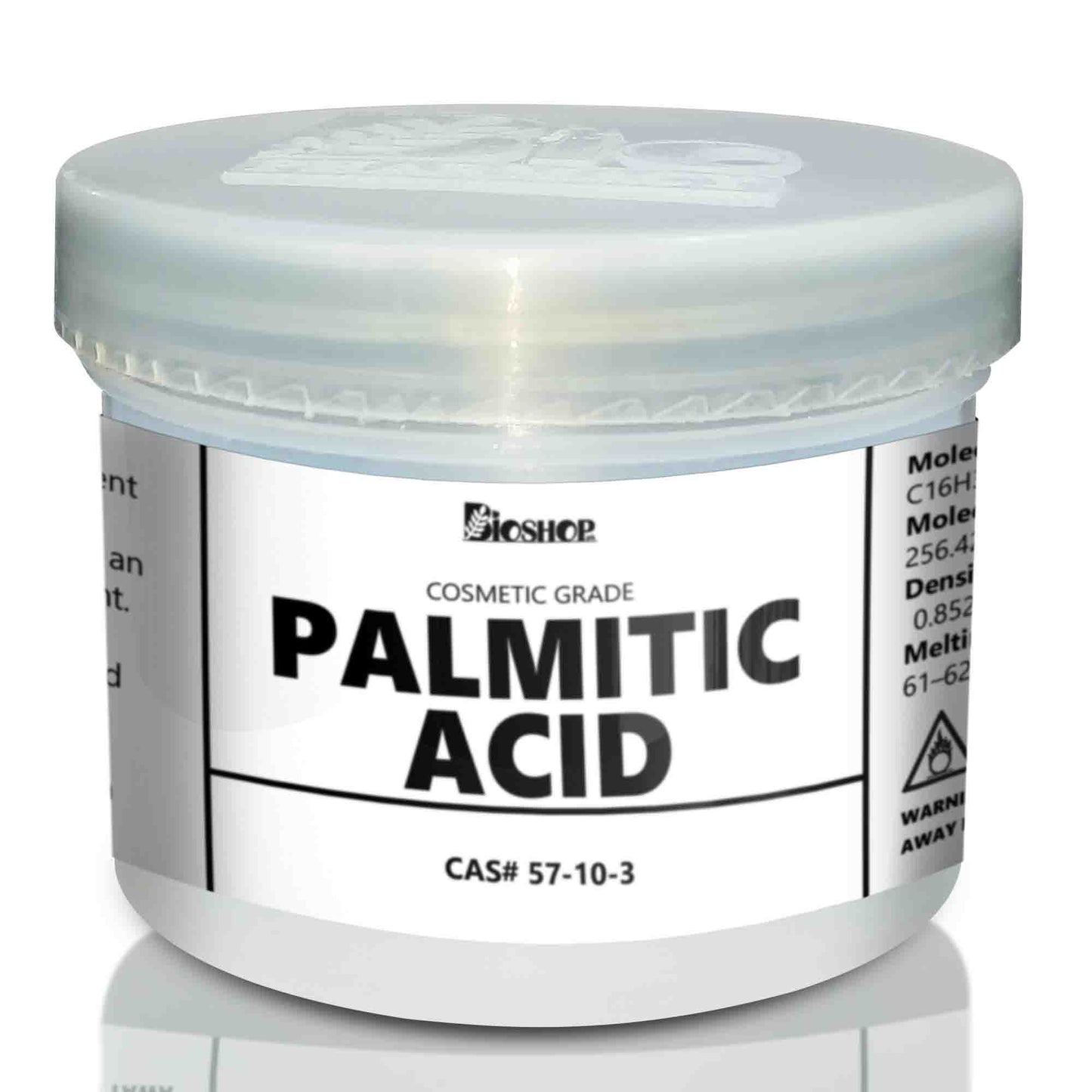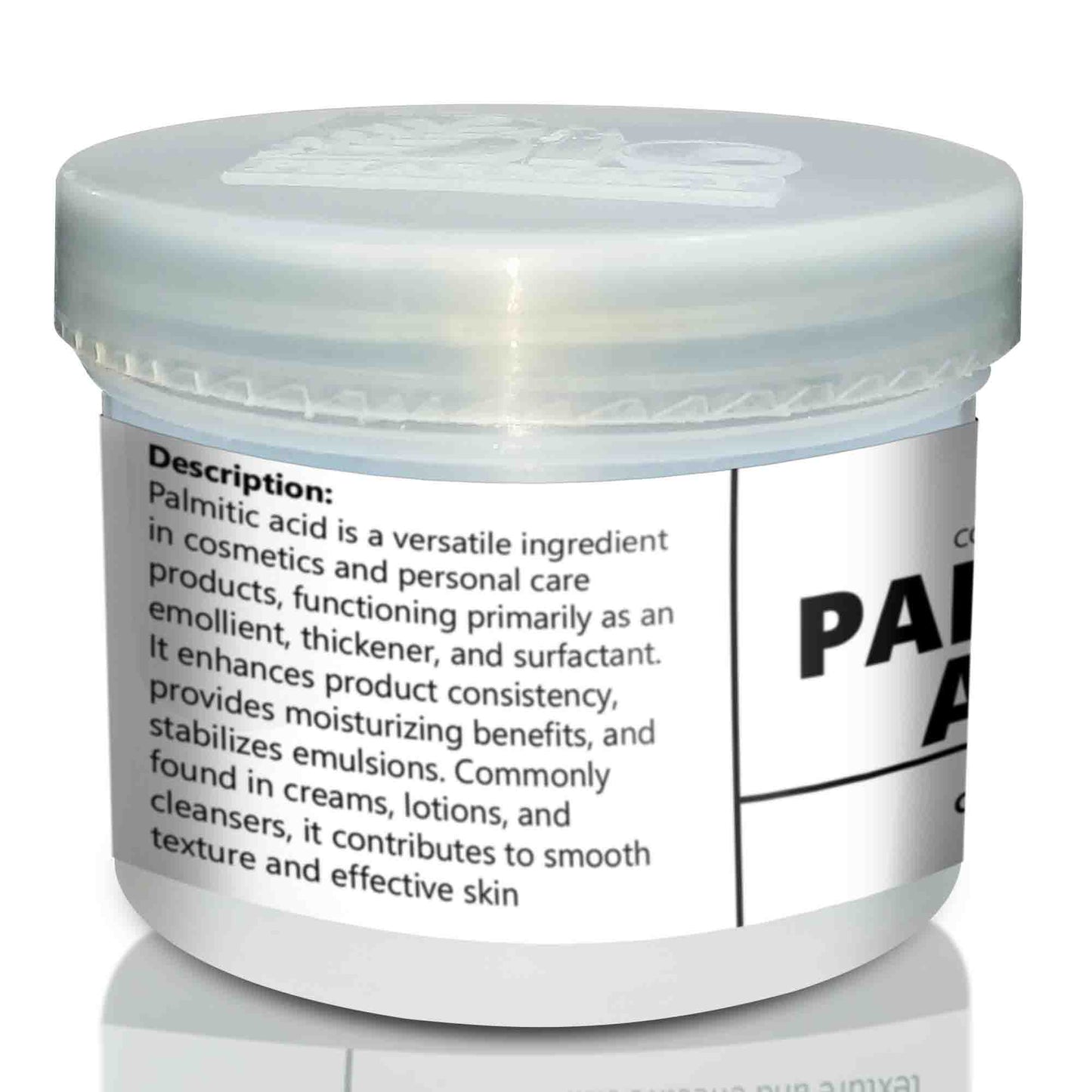Bio Shop
Palmitic Acid
Palmitic Acid
Key Functions: Acts as a thickener, co-emulsifier, and emollient in creams, lotions, soaps, and haircare.
Couldn't load pickup availability



Explore
Information About Palmitic Acid
✅ Key Features
- Improves viscosity and texture in emulsions and balms
- Supports emulsification and formula stabilization
- Provides emollient benefits and skin-softening properties
- Widely used in soaps for hardness and conditioning
- Boosts foam and cleansing in surfactant formulations
🔬 Description
Palmitic Acid – Fatty Acid for Thickening, Emulsifying & Conditioning
Palmitic Acid is a naturally occurring saturated fatty acid derived from palm oil, commonly used in cosmetics for its thickening, stabilizing, and skin-conditioning properties. It is an essential component in creams, lotions, hair masks, soaps, and cleansing bars, where it provides structure, improves foam, and enhances product glide. In cold-process soaps, it contributes to hardness and creamy lather, while in emulsions it serves as a co-emulsifier and emollient, leaving a soft, smooth finish on the skin and hair.
📊 Technical Data
INCI Name: Palmitic Acid
CAS Number: 57-10-3
Solubility: Oil-soluble
Add Phase: Oil phase (heated)
pH Stability: Stable across wide pH range
Processing Temperature: 65–80°C
Appearance: White flakes or powder
Odor: Odorless
Molecular Formula: C₁₆H₃₂O₂
Molecular Weight: 256.43 g/mol
Flash Point: > 200°C
Density: ~0.85 g/cm³
Chemical Type: Saturated fatty acid
Functional Groups: Carboxylic acid
Primary Cosmetic Uses: Emulsions, soaps, balms, surfactant blends
🧪 Recommended Usage
- Usage Rate: 1% – 10%
- Phase: Oil phase (heat required to melt)
- Ideal For: Lotions, Creams, Soaps, Cleansers, Hair Masks
💡 Pro Tip
🌿 When using in emulsions, pre-melt Palmitic Acid and blend into your oil phase for best dispersion. Combine with emulsifying wax or stearic acid for enhanced creaminess and glide.
👩🔬 Skin Type Compatibility
✔️ Suitable for dry and normal skin types
✔️ Non-irritating and well-tolerated in rinse-off and leave-on products
✔️ May be too heavy for acne-prone skin in high concentrations
🧴 Formulation Ideas
1. Rich Body Cream
Use 2–5% Palmitic Acid with shea butter and emulsifying wax to boost texture and glide.
2. Cold Process Soap
Incorporate up to 25% of total oils for firmness and a rich, stable lather.
3. Hair Conditioning Mask
Add 3% in the oil phase to give richness and help soften strands.
4. Lip Balm Base
Use with beeswax and cocoa butter to improve structure and consistency.
5. Cleansing Balm or Bar
Blend with surfactants or castor oil to enhance foam and cleansing efficiency.
💧 Cosmetic Suitability:
Serums
⭐☆☆☆☆ – Poor
🟥⬜⬜⬜⬜ – Too heavy for lightweight formulations.
Creams & Lotions
⭐⭐⭐⭐⭐ – Excellent
🟩🟩🟩🟩🟩 – Enhances structure and emolliency.
Toners
☆☆☆☆☆ – Not Suitable
🟥⬜⬜⬜⬜ – Not used in water-based tonics.
Face Masks
⭐⭐⭐☆☆ – Moderate
🟧🟧🟧⬜⬜ – Useful in creamy or nourishing masks.
Cleansers
⭐⭐⭐⭐☆ – Good
🟩🟩🟩🟩⬜ – Adds creaminess to cleansing bars and balms.
Hair Masks
⭐⭐⭐⭐☆ – Good
🟩🟩🟩🟩⬜ – Conditions and softens hair strands.
Deodorants
⭐⭐☆☆☆ – Fair
🟧🟧⬜⬜⬜ – May be used in balm-style sticks.
Eye Creams
⭐⭐☆☆☆ – Fair
🟧🟧⬜⬜⬜ – Add in low amounts for richer textures.
Shampoos
⭐⭐☆☆☆ – Fair
🟧🟧⬜⬜⬜ – Rare in shampoos but possible in cream shampoos.
Soaps
⭐⭐⭐⭐⭐ – Excellent
🟩🟩🟩🟩🟩 – Improves hardness and stable foam in cold-process soaps.
Conditioners
⭐⭐⭐⭐☆ – Good
🟩🟩🟩🟩⬜ – Adds richness and improves detangling.
Lip Balms
⭐⭐⭐⭐☆ – Good
🟩🟩🟩🟩⬜ – Boosts firmness and glide.
Body Butters
⭐⭐⭐⭐⭐ – Excellent
🟩🟩🟩🟩🟩 – Adds structure, smoothness, and nourishment.
Ointments
⭐⭐⭐⭐☆ – Good
🟩🟩🟩🟩⬜ – Emollient support in healing salves.
❓ FAQs
Q1: Is Palmitic Acid natural?
A1: Yes — it is found naturally in palm oil and animal fats.
Q2: Does it clog pores?
A2: In high amounts, it may be comedogenic for acne-prone skin. Use sparingly in facial formulas.
Q3: Is it vegan?
A3: If derived from plant sources (like Bio Shop’s version), yes — it is fully vegan.
Q4: Can I use it in cold-process soap?
A4: Absolutely — it’s a staple soap ingredient that improves bar quality.
Q5: What’s the difference between Palmitic and Stearic Acid?
A5: Stearic is longer-chain (C18 vs. C16) and produces a harder texture, while Palmitic provides more glide.
📂 Documentation
Upon request, we will provide.
Where Can You Safely Use Palmitic Acid
Discover how Palmitic Acid performs across different products — rated for safety, stability, and effectiveness.




